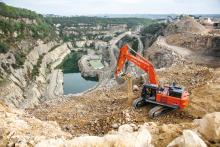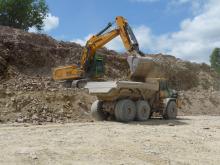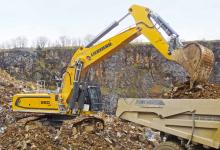After several years using crawler excavators with shovel loaders for rock extraction, S. C. Grandemar invested in two new Liebherr R 976 crawler excavators with backhoe attachments.
The Romanian company says it was impressed with the technical solution put forward by the manufacturer, but also with the after-care from the local
Following blasting, the machines load the mined material, (diorite and andesite rocks) into the buckets of the rigid dumper trucks which feed the crusher.
With an operating weight of 90tonnes, the excavators have been developed and manufactured at Liebherr-France in Colmar, and have a Liebherr diesel engine with capacity of 400kW, which complies with the emission standards of Stage IIIB/Tier 4i.
In terms of add-on tools and implements, the R 976 excavators have hydraulically elevating cabs and are both equipped with a Liebherr HDV backhoe bucket with a capacity of 4.7m³, a 7.2m mono boom, and a 2.9m stick.
Satisfied with the purchase of an R 974 crawler excavator with shovel attachment in 2007, S. C.
Liebherr says that the two R 976 machines with backhoe attachments won over the Romanian company with their “cost-effectiveness and productivity.” They have an average fuel consumption of 40-45litres/hour and an ideal bucket capacity.
The R 976 deployed at Bologa achieves a production rate of 400tonnes/hour, which is said to be the ideal for the volume of the crusher.
Although similar productivity would have been possible with a lighter crawler excavator, this application, along with the hardness of the rock, demanded an excavator of significant weight to guarantee optimum performance, says Liebherr.
S. C. Grandemar specified the two new excavators with multiple protective elements on the rotating mechanism and the pipes; on the piston rods of the boom and bucket, and on the bottom of the stick.
The machines also have floor plates for the undercarriage and the middle part of the undercarriage. This additional protection ensures maximum durability of the machine components.
The large, comfortable and ergonomic cabs provide ideal operating conditions in a difficult work environment, and besides a 7” high-resolution colour touch screen, the R 976 crawler excavators are equipped with an impact-resistant front window and roof window as standard, as well as front guard protection structure (FGPS) and falling objects protection structure (FOPS). A cab elevation ensures optimal visibility of the working zone.
As well as the technical solution proposed by Liebherr-France, the local support provided by Liebherr-Romania also played a major role in the final decision.
The company was founded in 2005 and is responsible for the sales and maintenance of Liebherr construction machines, crawler cranes and mobile cranes in Romania.
Liebherr says that with a branch located in Cluj-Napoca, this local presence of Liebherr ensures the quick response of service technicians and fast supply of spare parts: key reasons for the largest quarry operator in the country.
Active in quarrying since 1873, S. C. Grandemar is currently the largest company in the sector in Romania.
With its head office in Cluj-Napoca, the company has approximately 140 employees and owns seven quarries, five of which are actually operational: Poieni, Bologa, Pietroasa, Morlaca and Moigrad.
Whether it is in Romania or abroad, the quality of the aggregates extracted in the region, diorite and andesite, are particularly sought-after by numerous companies in the railway industry and for road construction.








